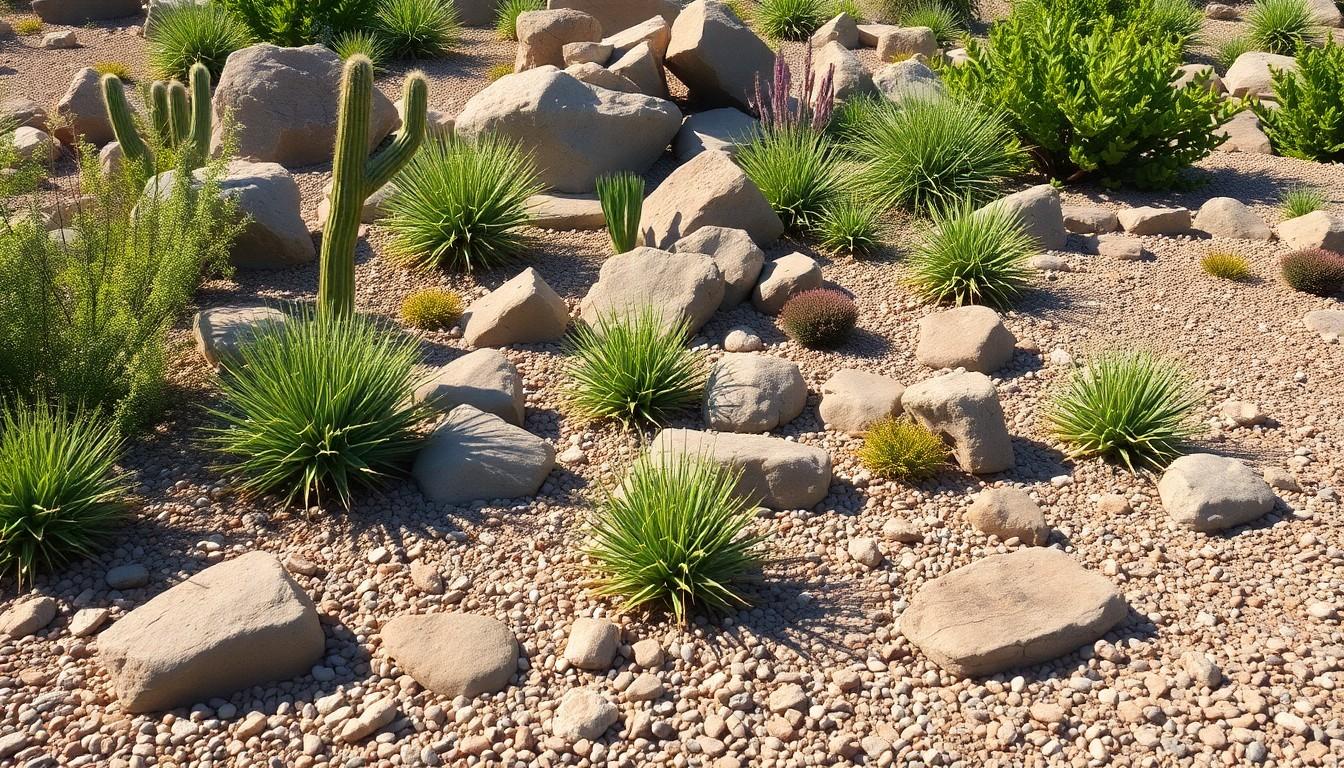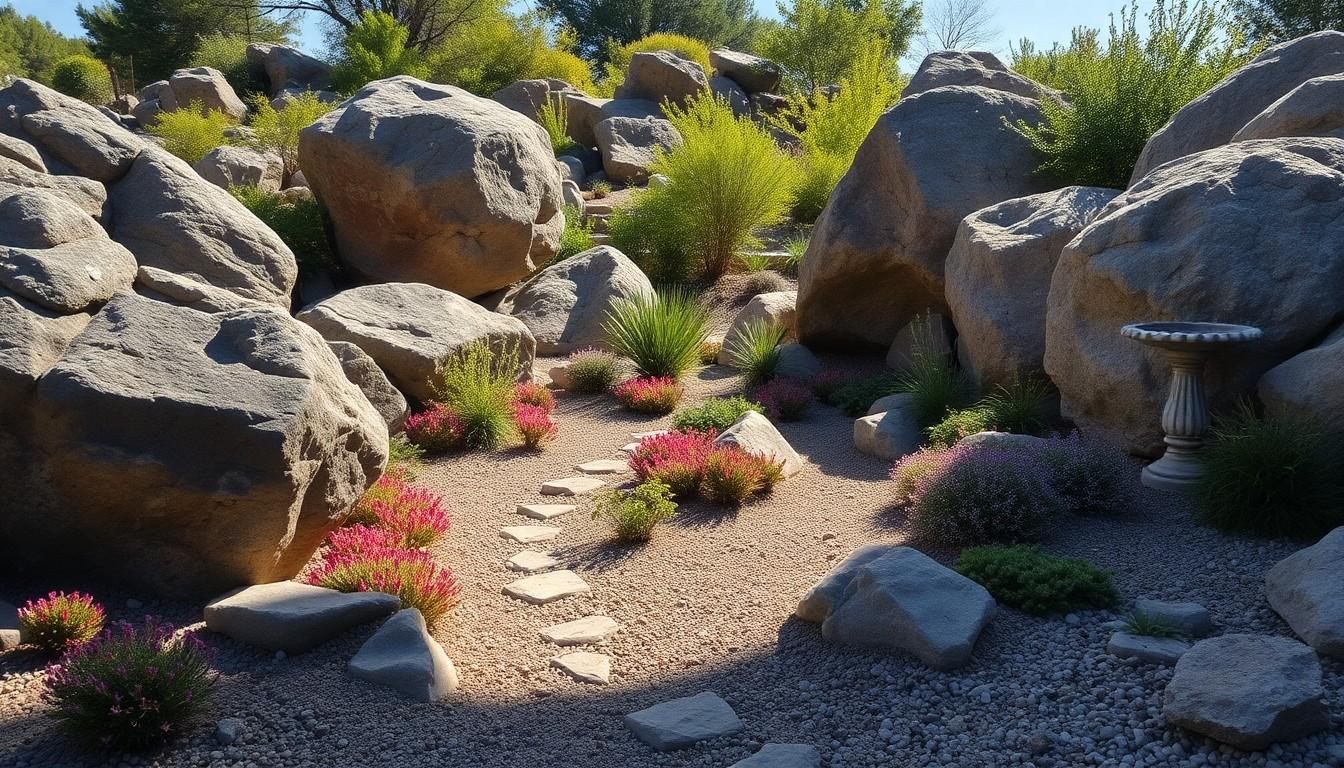Imagine transforming your outdoor space into a serene oasis without the endless hours of upkeep. Low maintenance rock gardens are the answer to every gardener’s dream. With their rugged charm and minimal fuss, these gardens offer a stylish solution for those who’d rather sip lemonade than wield a weed whacker.
Low Maintenance Simple Rock Garden Designs
Low maintenance rock gardens offer distinctive aesthetics while minimizing the need for regular care. These gardens use a combination of stones, gravel, and hardy plants that thrive in rocky conditions. Simple designs focus on functionality and visual appeal, creating spaces that require less water and fewer resources.
Common elements include various rocks and stones, which serve multiple purposes. Large boulders can act as focal points, while smaller stones fill in gaps and provide texture. Gravel paths often integrate seamlessly, allowing for easy navigation without disturbing the surrounding plants. Selecting drought-resistant plants, such as succulents or native grasses, enhances the garden’s sustainability.
Plant arrangements consider size, color, and texture. Grouping similar plants together creates a cohesive look, while contrasting leaf shapes and colors add interest. Choosing plants that flower at different times ensures visual appeal throughout the seasons.
Consider incorporating decorative features like wind chimes or birdbaths. These additions can enhance the garden’s charm without complicating maintenance. Rainwater catchment systems can also contribute to sustainability by providing a natural source of irrigation, decreasing reliance on manual watering.
Designing a low maintenance rock garden involves planning for drainage and sunlight exposure. Adequate drainage prevents waterlogging and ensures that plants thrive. Placing the garden in a sunlit area allows sun-loving plants to flourish while reducing moss and algae growth.
Overall, simple rock garden designs create a tranquil atmosphere without demanding extensive upkeep. Individuals can enjoy the rugged beauty of nature while spending more time relaxing in their outdoor oasis.
Benefits of Rock Gardens

Rock gardens provide numerous advantages that enhance their appeal for outdoor spaces. Their unique design elements contribute to a more sustainable and enjoyable gardening experience.
Water Efficiency
Rock gardens excel in water efficiency, primarily due to the use of drought-resistant plants. Such plants require minimal watering, making them ideal for regions with limited rainfall. The stones and gravel used in the garden help retain moisture while allowing for proper drainage. This combination reduces the need for frequent irrigation. By incorporating these elements, rock gardens support eco-friendly gardening practices. They contribute to conservation efforts and lower water bills for homeowners.
Low Upkeep
Low upkeep represents one of the key benefits of rock gardens. Once established, they require little maintenance, allowing for more leisure time. Weeds grow less frequently in gravel and stone environments, decreasing the need for regular weeding. Additionally, the sturdy materials used in rock gardens resist deterioration, reducing repair costs. Hardy plants thrive in these settings, promoting resilience against pests and diseases. Minimal pruning and care ensure that rock gardens remain attractive year-round. The relaxation gained from reduced gardening chores enhances one’s enjoyment of outdoor spaces.
Key Elements of Rock Garden Designs
Low maintenance rock gardens thrive on simplicity and functionality. Key elements work together to create a harmonious outdoor space.
Rocks and Stones
Rocks and stones serve as the backbone of rock gardens. Large boulders act as focal points, establishing visual interest. Smaller stones provide texture and contrast throughout the design. Positioning stones in groups enhances their impact, drawing the eye to specific areas. Gravel paths facilitate movement while preventing soil erosion. Choosing a mix of colors and sizes contributes to a natural appearance. Utilizing local stones can improve integration with the surrounding landscape. Overall, selecting appropriate rocks and stones ensures durability and aesthetic appeal.
Plants and Vegetation
Plants and vegetation play a crucial role in rock garden designs. Drought-resistant species thrive in these environments, minimizing water needs. Succulents and alpine plants offer vibrant colors and unique shapes. Arranging plants in clusters creates layered visuals, enhancing depth. Space between plants allows for growth without overcrowding. Native plants can adapt well, supporting local wildlife and ecosystems. Incorporating ground covers helps control weeds while adding greenery. Selecting the right plants promotes resilience and reduces maintenance tasks.
Popular Low Maintenance Simple Rock Garden Designs
Low maintenance rock gardens come in various styles, each offering unique benefits. Two popular designs include gravel gardens and alpine gardens.
Gravel Gardens
Gravel gardens utilize a layer of gravel to create a clean and low-maintenance landscape. This design simplifies weed control, as gravel minimizes sunlight that reaches the soil below. Incorporating drought-resistant plants like Sedum or thyme provides greenery without extensive irrigation. Paths made of larger stones or decorative gravel facilitate easy navigation throughout the garden. The combination of plants and gravel allows for effective drainage, ensuring plants thrive in dry conditions. Layering different sizes of gravel not only enhances visual appeal but also promotes efficient water retention.
Alpine Gardens
Alpine gardens replicate the unique ecosystems found in mountainous regions. Employing rock formations and hardy alpine plants creates an eco-friendly space that thrives in well-drained conditions. Species such as saxifraga and dianthus flourish, providing vibrant color with minimal upkeep. Using native stones as the foundation creates a natural aesthetic that blends with surrounding landscapes. Arranging plants in clusters mimics their natural habitats, enhancing biodiversity. A well-planned alpine garden offers resilience against harsh weather, showcasing beauty while requiring little maintenance.
Tips for Creating Your Own Rock Garden
Creating a rock garden involves thoughtful planning. Consider the following tips to ensure a successful design.
Site Selection
Choosing the right location is crucial for a thriving rock garden. Identify an area that receives ample sunlight, ideally six to eight hours each day. Evaluate drainage patterns to position your garden in an area that avoids excess water pooling. Prioritize sloped or raised locations since they facilitate natural drainage. Look for existing features like trees or pathways that can enhance the garden’s integration into the landscape. Select a site that is easily accessible for maintenance while still providing a sense of seclusion.
Plant Choices
Selecting the right plants is vital for a low-maintenance rock garden. Focus on drought-resistant varieties such as sedums, thyme, and succulents that thrive in rocky environments. Assess the climate and soil conditions to choose species that will flourish in the selected site. Incorporate perennial plants that return each year, reducing the need for replanting. Consider varying plant heights and textures to create visual interest and encourage biodiversity. Use ground covers to minimize weed growth while enhancing the overall appearance of the garden.
Enhance Outdoor Spaces with Minimal Effort
Low maintenance rock gardens offer a fantastic way to enhance outdoor spaces with minimal effort. Their unique combination of stones and hardy plants not only creates stunning visuals but also promotes sustainability. By choosing drought-resistant varieties and thoughtful designs, gardeners can enjoy a beautiful landscape that thrives with little intervention.
These gardens are perfect for those seeking tranquility in their yards while reducing water usage and upkeep. With the right planning and plant selection, anyone can create a rock garden that stands the test of time, providing a serene retreat for relaxation and enjoyment. Embracing this gardening style can lead to a fulfilling and eco-friendly outdoor experience.

